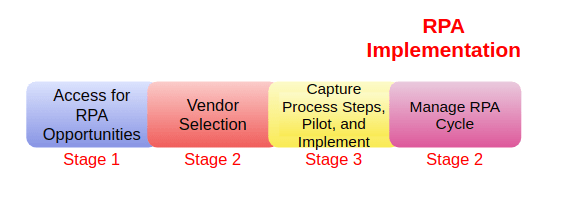RPA Implementation
RPA software has provided an excellent option for corporate and shared services. It is an efficient, cost-effective alternative to traditional process approaches. RPA implementations are increasing in popularity due to the money and resources according to time. Once the organizations make sure to implement RPA, they are required to move forward with a stage-wise implementation approach.
To implement RPA successfully in an organization, the organization must use time-tested and robust methodology. RPA implementation mainly depends on the requirements of the organization. It typically includes the following stages:

Stage 1 – Access for RPA Opportunities
Organizations should find the right business processes before the implementation of RPA technology. Implementation with the right processes can be beneficial for organizations. Every process in the business may not be suitable for the RPA implementation. Therefore, organizations should conduct a high-level assessment of the potential processes and select the right processes to be automated. It will help them to decide whether RPA is a good fit for their organization or not.
Once an organization has decided to implement this technology, they should set the objectives of the RPA initiative. It will be an excellent choice to get an agreement from executive stakeholders on project objectives.
This initial stage examines which areas will get the most benefit by switching to RPA technology. It also includes technology demonstrations by selected RPA vendors to serve as a POC (Proof of Concept) and platform for knowledge gathering.
Stage 2 – Select a Vendor
In this phase, organizations start finding RPA vendors based on the technical requirements of the organization. The selection process is an opportunity for RPA providers or vendors to show how they meet the requirements and criteria of the organization.
Organizations invite different RPA vendors to take part in the on-site presentation and show how RPA can help with the growth of the company. Many vendors agree to demonstrate the whole presentation by applying RPA technology to the selected processes as a proof of concept.
Then, organizations select a vendor that complies with their requirements and business objectives. There are two types of implementation that RPA vendors may present:
- RPA vendors will conduct the configuration and test for the organization.
- RPA vendors will sell bot licenses and teach how to implement them.
Most vendors provide both of these services. So, it depends on the requirements of the organization to choose any of these ways for the implementation. Many businesses opt for a vendor to code the initial pilot and develop an internal RPA center of expertise to handle future implementations.
Stage 3 – Capture Process Steps, Pilot, and Implement
During this stage, businesses ensure whether human resources are trained and ready to execute the selected RPA implementation plan. This stage also includes the activities required to support and test the IT environment. All the implementation activities are documented, tracked, and completed as per the defined criteria.
This stage also includes the facilitation of the pilot for the selected process areas or use cases. It allows businesses to observe the effectiveness and overall performance of the automation plan with an actual process in real-time.
As per the results of the pilot project, businesses may include scenarios that need to be automated, which showcase the full extent of the RPA technology. If there is any problem, then the RPA development team analyzes and resolves it. It further establishes the groundwork for upcoming state operational models.
Stage 4 – Manage the RPA Lifecycle
In this stage, the initial launch of RPA is processed. This stage also includes the planning for the ongoing success of RPA software through proactive maintenance. This strategy should combine governance, operating model, organizational structure, and change management plan of the RPA solution. There should be a good change management plan to estimate the impact of change in processes and systems. So, the businesses will be able to limit the margin of error as they proceed.
Keys to Successful Implementation
Before implementing RPA technology, organizations should consider the following keys which will help in successful implementation:
- Select the right project team for internal and external operations.
- Execute detailed work plans to ensure that no work is dropped.
- Form quick connections with IT, controls, and procurement.
- Estimate the impact of changes in people.
